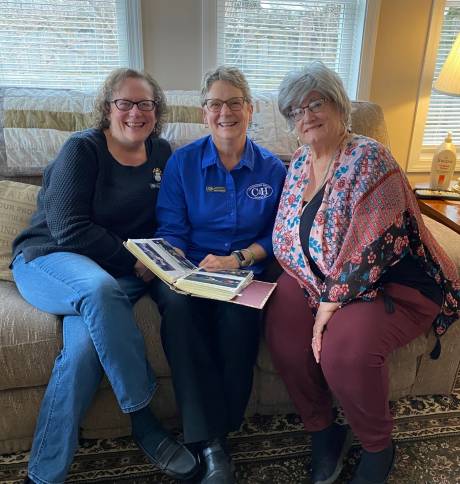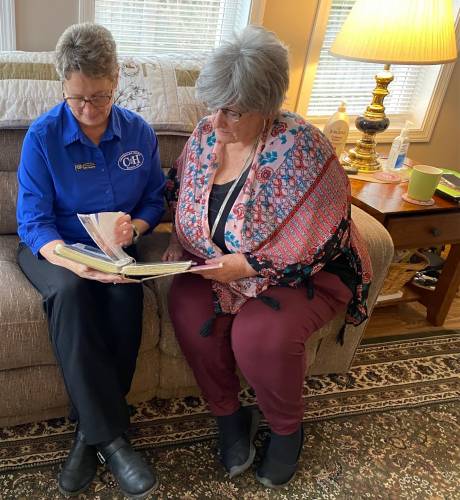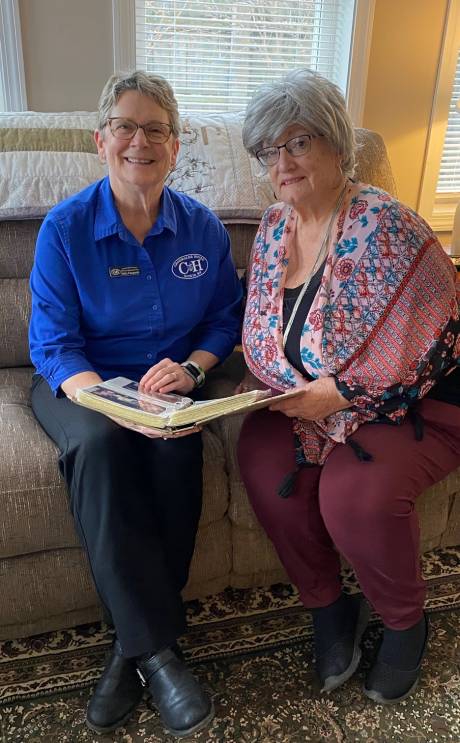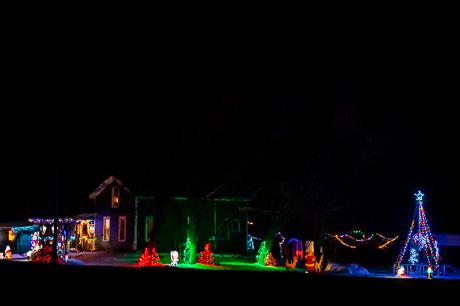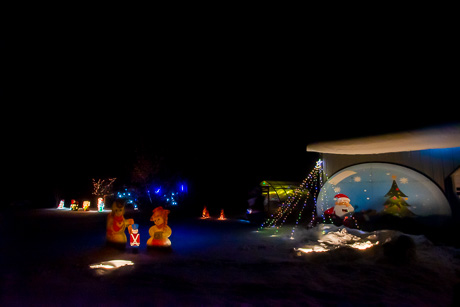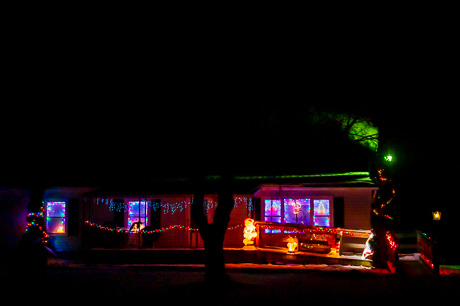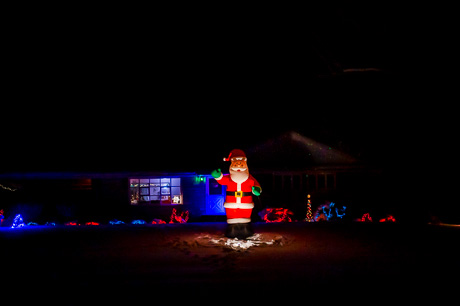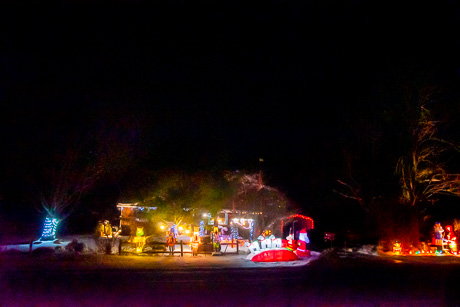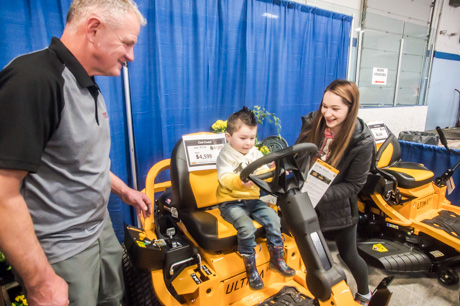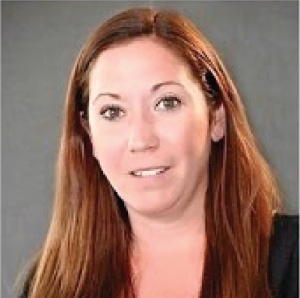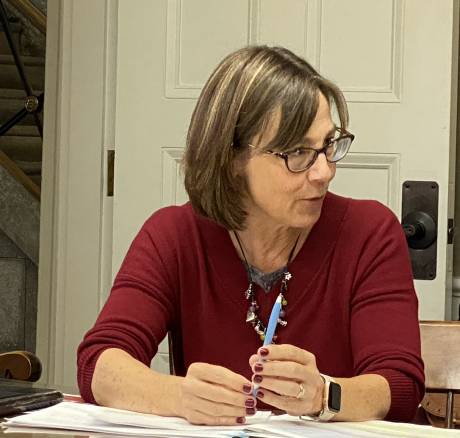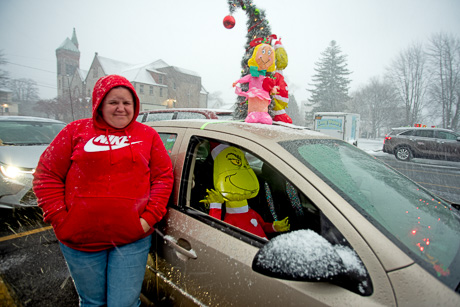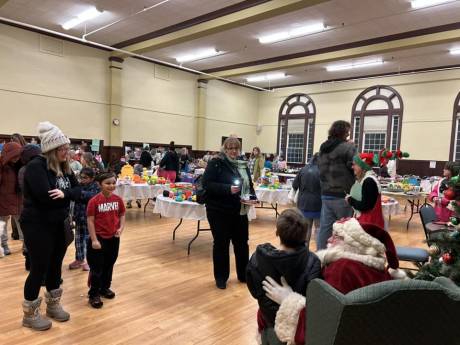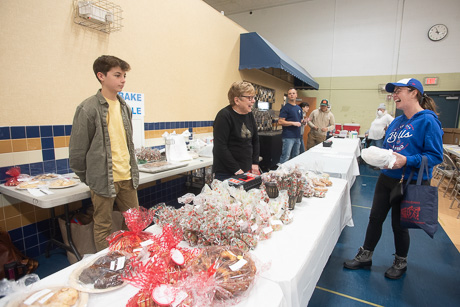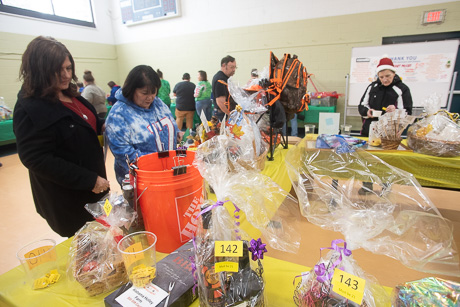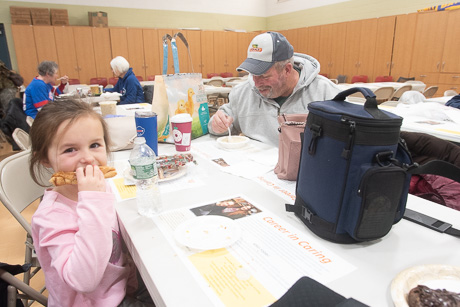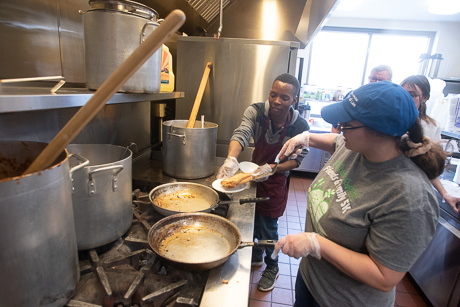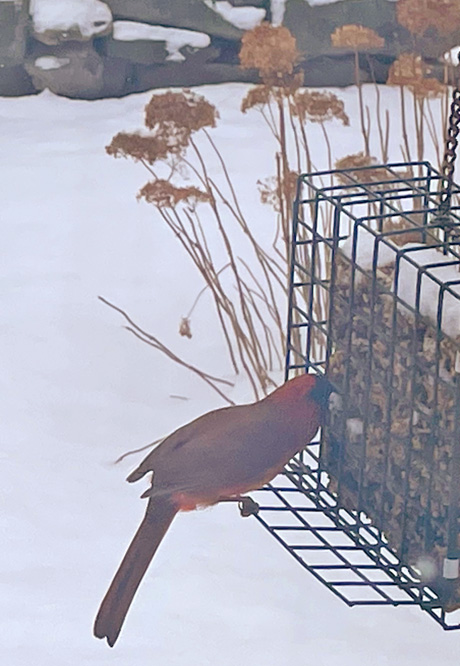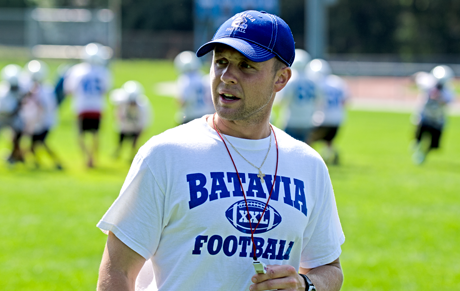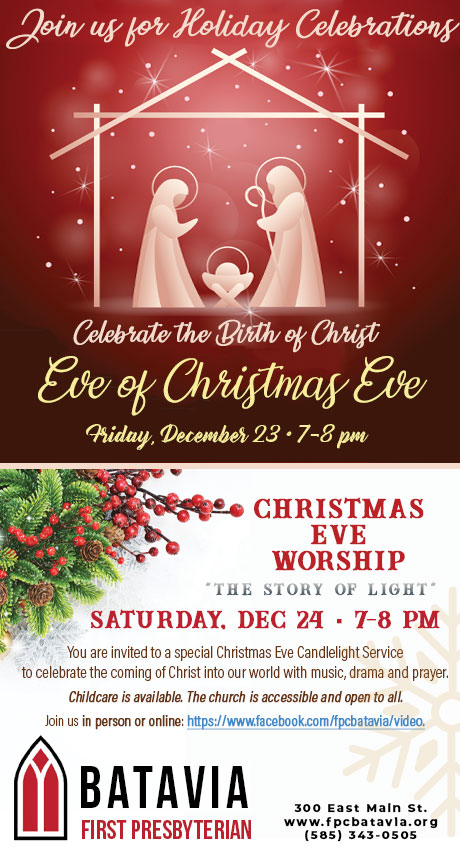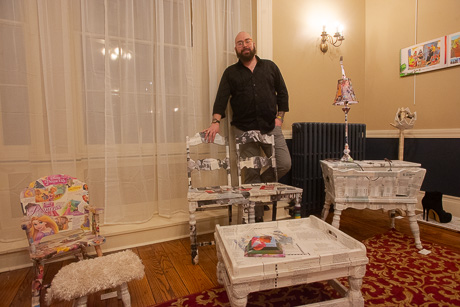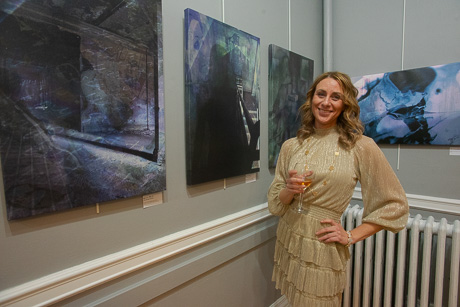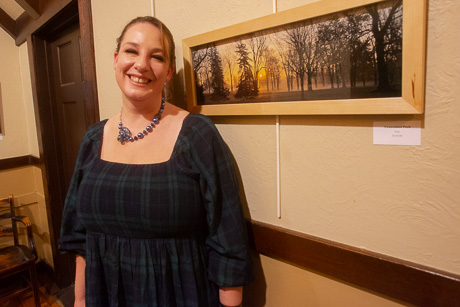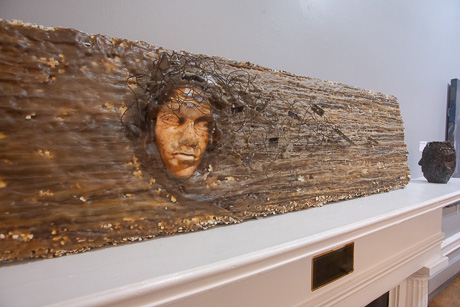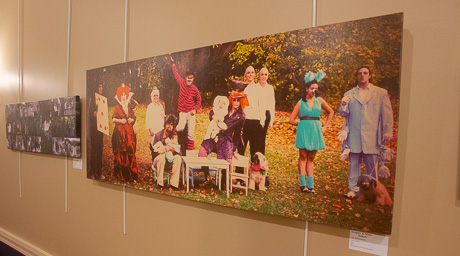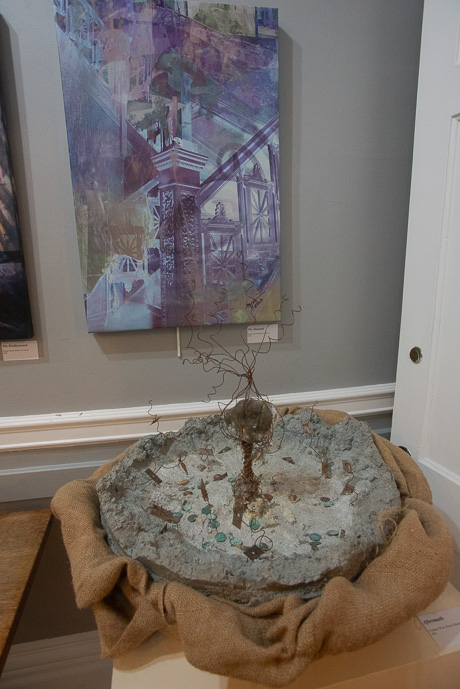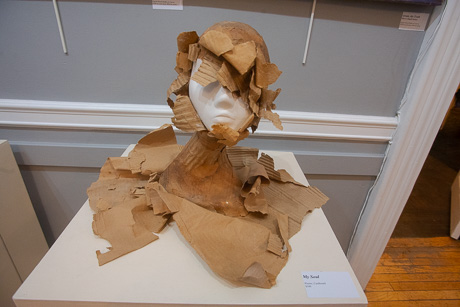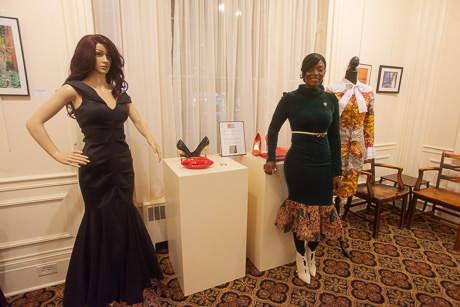Gregory Hallock hid his personal life for “a very long time,” before realizing that he needed to be a better role model for his children.
The GO ART! executive director and father of two stepped out from the shadows to display that it’s ok to be who you are.
“Coming out was hard for me. I prayed to God every day to make me not gay,” Hallock said of his life up to his mid-20s. “My then-husband and I decided that we have to be proud of who we are. And we want our children to be proud of who they are.”
That love and respect he has for himself, his family and his children — Augustus, 7, and 10-year-old Cattaleya — has been folded into a 15-piece exhibit of various artworks that tell “My Journey” at the Genesee Orleans Regional Arts Council, 201 East Main St., Batavia.
It was a colleague, Mary Jo Whitman, working as art coordinator for Genesee Community College, who prompted Hallock to submit his first piece in 2016.
“I was doing a piece for a charity auction. And I was selling that piece. And they were auctioning it off, and I bought it back because it didn’t go for what I thought it was worth. And Mary Jo … they were doing an alumni show, and she asked me to apply for the show. So I applied, thinking that I would be putting in that one piece. Only six artists got selected. And she's like, 'you got selected, now I need the rest of your collection,'” he said. “So I added to the collection, and I decided the initial piece was about love. I had taken two chairs that were exactly the same, I cut out half of the seats on both of them … and I combined them to make a bench. For us, we were two separate people that weren't allowed to be together because of being homosexual. And then we were allowed. So that was our love coming together. So from there, I decided to create a collection based on my journey through life.”
Now 42, Hallock has embraced his persona, which has been steeped in the performing arts, having gone to school for theater, acting and dancing. He was not one to give up easily, and in fact, is “very competitive,” even to the point of making sure to win every coloring contest as a kid.
"My first piece, “(I’m) Coming Out” is a collection of stories from all different people about moments in their life, that, upon looking back on, they realized they were literally 'born this way,'" he said. "I have attached them to a closet door in representation of my childhood and the moment I came out at age 24."
His pieces use materials, such as the wooden chairs, that have been created from two separate pieces to meld into one unified bench. Even his children’s school work has been incorporated into his imagination through decoupage. The collection has been a gradual accumulation of work, much of which was found when a staffer was cleaning out his office. Much of the pieces are from objects found — literally in the street, he said — and fashioned into something meaningful, often weaving family into them.
“I love the arts, fine art is something I have not pursued, he said. “I did that collection to make people smile. In general, it just makes me smile. This is my now. There’s a meaning behind every piece. For photographs, I would make my whole family do a photo shoot with costumes.”
During his first adoption process, it went much quicker than expected, and before he knew it, Hallock and his former husband welcomed Augustus as part of the family. Then Jezebel the dog, a wheaten terrier, got pregnant and had seven puppies. His life had become wrapped up in pregnancies, and he loved every moment of it, he said.
Hallock then had the privilege of cutting Cattaleya’s umbilical cord during his second adoption, and it further strengthened his fatherhood — and personhood — experience, he said.
“And then came the biggest day of our lives: “Our Little Princess” (also one of his pieces) was born. I remember swearing that I would never buy Disney clothes or in general be that Disney person,” he says in the exhibit statement. “Well, I failed. I am 100 percent that Disney person, but when you have a daughter how can you avoid it (excuse, lol).”
Fast forward six years, and his “now” has changed, he said, to having a 10-year-old daughter, seven-year-old son who was adopted at age four, plus five chickens, two dogs, two gerbils, one cat, one hedgehog, and one fish. He is "flying high" despite having encountered some bumps along the way.
"I have been working my dream job for nearly seven years, I have gone through a bout of cancer, a separation bought a house and am living life to its fullest," he said.
He credits his family for supporting everything in and about his life -- including dressing up in costumes for photos --- and his mom's handiwork of crocheted ornaments and stockings is included in the exhibit as well.
He has a tattoo that simply states where he’s at these days: “love for all, hate for none.”
Mary Jo Whitman always had an interest in art, she said, and pursued that by obtaining an associates, bachelor and master degree in fine and studio arts, sculpture, and finally, critical museum studies. Her goal was to become a professor, which she accomplished as an adjunct at GCC.
Whitman also wanted to get involved in an art gallery or museum, she said, and was art coordinator at GCC. She is currently at GO ART! as an educational statewide community regrant program director. Long titles aside, Whitman’s craft is short on boring — bringing multiple facets of images together as a completed visual.
“I’m very interested in human behavior and how we come to identify ourselves. So I believe that our identities are socially and culturally constructed. Meaning that every single aspect of your personality, your beliefs, everything that makes you a person has been influenced by someone or something else that you've come in contact with through your life,” Whitman said. “And taking that on the next level, as adults to really be successful in life, you really have to be able to assimilate to whatever situation you're presented with. I really got into what is the psychological impact … who are you at the very root of it.”
Although she answered that for herself through these pieces — there’s an image of Whitman in every photo — she’s reluctant to share that with the world. Considered “very personal,” she wants instead for viewers to interpret for themselves what each piece means, and how they feel when they see it.
Her 18 pieces, “Deconstructed and Raw,” include sculptures and digital photos culled over the last decade, with the last two years being devoted more to the digital realm.
“I’ve always had an interest in art, pretty much my entire life. I went to school for art. And I've always, within doing my art, I'm always experimenting with different mediums, trying different things. I decided, after taking some courses in digital art, I really enjoyed being able to manipulate images in Photoshop,” Whitman said. “I like the kind of freedom it gave you. Because you can't really make mistakes. You know, when you're doing a painting or something, if you make a mistake, it's hard to kind of rectify it where and when you're working in a digital capacity, it's easy; I could just undo whatever I just did.
“I dissect myself into different identities, and break them down,” she said of her “The Disillusioned” piece. “Once the work is shown publicly, it’s the audience’s responsibility to interpret.”
Whitman was doing her grad school research, being drawn heavily into the idea of identity construction, she said.
“And so, in looking at this, I really got interested in what is the psychological impact of knowing that your identity is constructed: who would you be if you had not been influenced by this specific thing, or that specific thing?” she said.
Backdrops are taken from obscure places, such as her gutted basement with pieces of dropped ceiling torn down. That construction material is shot in wide angle with other images positioned on top and merged.
"And when it was on the floor, I was just kind of, you know, enamored with this, these materials, it was all broken up and dusty. So I started taking photographs, I took these very low wide angle photos of it. And usually, when I'm doing one of these digital images, that's my first thing I go to, as I find the central background image of it, and it's usually something wide angle, you know, from an unusual perspective, so that was kind of fitting into it," she said. "And, you know, it was kind of telling through some things that I had going on, ... and I scanned in these incomplete drawings and manipulated them so tha they're overlaid of this image, and then there' an image of me ... And then just kind of put this like introspective silhouette kind of image of myself, it's like sitting amongst this rubble."
Whitman plans to have other exhibits in the next year, she said, depicting “that mode of anxiety of who am I right now? I enjoy the human behavior.”
"I attribute much of the success in my life to my ability to assume whatever identity is necessary to function within any social situation with which I am presented. My appearance, my clothing, my mannerisms, my vocabulary, and even the tone of my voice differ from situation to situation. I am the crazy hippie, dancing barefoot at a festival as my flowing skirt chases me. I am the curator, entertaining pretentious conversation in stilettos," Whitman said. "I am the smart-ass bartender, donning pigtails and a bowtie with a mischievous grin. I am the country girl in mud-covered, ripped-up jeans, destroying targets with a shotgun and riding four-wheelers. I am an artist, conceptualizing all my observations in an array of mediums, often in wax and plaster-covered clothing. I am a sister. I am a daughter. I am an aunt. I am a mom. The sheer size of my closet can attest to how many different people I can be and who I may need to be at any given moment.
"So, who am I beneath the fractured and fluid identity which has been constructed in accordance with societal expectations? The truth is, I am all of these identities… and none of them at the same time," she said in her artist statement.
How does Program Coordinator Jodi Fisher feel about her first exhibit, “Pictures and Prose?”
“It’s nerve-wracking,” she said.
Her 22 photographs of mostly color scenes focus on the outdoors, nature, and, really, “anything that’s interesting or out of the ordinary,” she said.
One muse she’s drawn to is the sky — she loves”I love taking pictures of the clouds and the infinite blues” — and gaze into Centennial Park.
“I’ve always been into art, and have never been able to draw,” she said. “I’ve always been into poems and poetry — m mom used to read poems to me every night.”
Now that she’s discovered a special lens for the iPhone — noted for capturing “amazing” photos by users these days — Fisher plans to home in on the fine details of close-ups, called “extreme detail photography.”
“I just see something beautiful,” she said. “I don’t necessarily see it as art, it speaks to me in some way or another. It sometimes tells a story about something, like an abandoned building.”
Her poem “Autumn” aptly describes a photo of those leafy trees:
Autumn
The sun peaking through
The leftover autumn leaves
Casting shadows on the ground
Blue skies above the canopy
The sweet fragrance wafting up
From the forest floor
The sharp crunch with each step
As you trek across the uneven soil
You are transported back
To a time before the lands were spoiled
Before the trees were stripped
And if only for a moment you are one with everything around you
You are Autumn
She began writing poetry, and “wanted to incorporate that with photos,” she said. “Poems and songs have always intrigued me. Those were my nighttime stories.”
The exhibits of Whitman and Fisher will be through Feb. 18.


